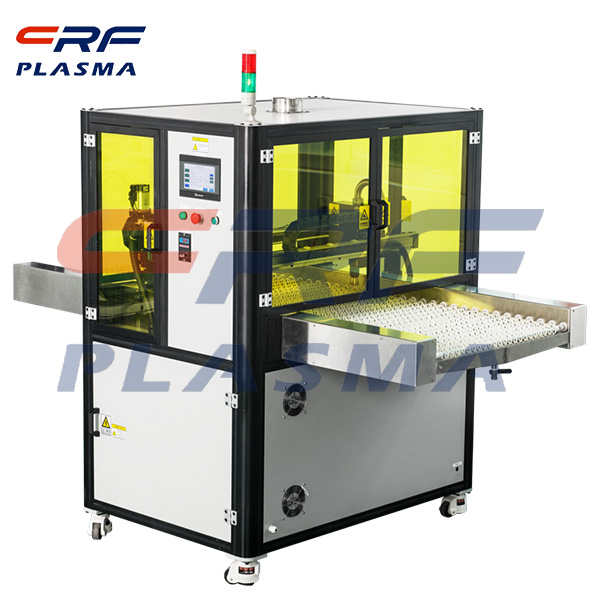
Welcome to Shenzhen Sing Fung Intelligent Manufacturing Co., Ltd.
E-mail:shaobo@sfi-crf.com
Plasma Surface Modification Graft Polymerization of Metal Polymer Materials
- Categories:Company Dynamics
- Author:plasma cleaning machine-surface treatment equipment-CRF plasma machine-Sing Fung Intelligent Manufacturing
- Origin:
- Time of issue:2021-02-19
- Views:
(Summary description)Graft polymerization is one of the commonly used methods in plasma surface modification. The grafting of appropriate monomers or polymers can improve the hydrophilicity, adhesion, corrosion resistance, electrical conductivity and biocompatibility of metal polymer materials. Agnesr, Denes et al. grafted polyethylene glycol (PEG) onto the surface of stainless steel by plasma surface modification. XPS results showed that the introduction of a large number of -CH2-CH2-O groups on the surface of stainless steel could significantly improve the surface hydrophilicity of the material. It can reduce the roughness and greatly reduce the adsorption of bacteria on the surface of the material. In the treatment of coronary vascular disease, the common clinical method is to do coronary angioplasty (PTCA). That is, in the blood vessel with metal dilator will be open, but the polymer metallized Steetan fixed film used in them still has a high coagulation, so the blood vessel will be restenosis. Lahann et al. polymerized p-xylene chloride on the surface of polymer metal by CVD method, and then treated with SO2 microwave plasma. The results show that the contact Angle is reduced to 15 degrees after treated with SO2 plasma, and the hydrophilicity of the material surface is improved. The adhesion between polymer and metal is involved in the grafting of polymeric organic matter on the surface of metal plasma or the metallization of polymer surface. E.C.Zhang et al. studied the adhesion of polytetrafluoroethylene (PTFE) to metal aluminum. They first pretreated PTFE with an argon plasma at a frequency of 40kHz, a power of 35W, and an argon pressure of 80Pa. And its exposure to the atmosphere about 10 min to produce oxide and peroxide, and then conducted on the acrylic ester of glycerol alcohol namely GMA graft copolymerization, and then to thermal evaporation aluminum, make with GMA graft copolymer of PTFE and PTFE is the adhesion force between A and 22 times between Al, that only by Ar plasma pretreatment of 3 times between PTFE and Al. E.D ayss respectively with three methods (mechanical casting rough method, oxygen, nitrogen, argon, low pressure plasma and produce interlayers method) to deal with polypropylene, research metal polymer on the adhesive properties, the results show that mechanical casting rough method in the improvement of adhesion of polypropylene and q of copper is valid, but the plasma treatment can lead to better results, especially the Ar plasma, plasma polymerization of acrylic acid middle tier contains C - 0 keys showed very strong adhesive.
Plasma Surface Modification Graft Polymerization of Metal Polymer Materials
(Summary description)Graft polymerization is one of the commonly used methods in plasma surface modification. The grafting of appropriate monomers or polymers can improve the hydrophilicity, adhesion, corrosion resistance, electrical conductivity and biocompatibility of metal polymer materials.
Agnesr, Denes et al. grafted polyethylene glycol (PEG) onto the surface of stainless steel by plasma surface modification. XPS results showed that the introduction of a large number of -CH2-CH2-O groups on the surface of stainless steel could significantly improve the surface hydrophilicity of the material. It can reduce the roughness and greatly reduce the adsorption of bacteria on the surface of the material. In the treatment of coronary vascular disease, the common clinical method is to do coronary angioplasty (PTCA). That is, in the blood vessel with metal dilator will be open, but the polymer metallized Steetan fixed film used in them still has a high coagulation, so the blood vessel will be restenosis. Lahann et al. polymerized p-xylene chloride on the surface of polymer metal by CVD method, and then treated with SO2 microwave plasma. The results show that the contact Angle is reduced to 15 degrees after treated with SO2 plasma, and the hydrophilicity of the material surface is improved.
The adhesion between polymer and metal is involved in the grafting of polymeric organic matter on the surface of metal plasma or the metallization of polymer surface. E.C.Zhang et al. studied the adhesion of polytetrafluoroethylene (PTFE) to metal aluminum. They first pretreated PTFE with an argon plasma at a frequency of 40kHz, a power of 35W, and an argon pressure of 80Pa. And its exposure to the atmosphere about 10 min to produce oxide and peroxide, and then conducted on the acrylic ester of glycerol alcohol namely GMA graft copolymerization, and then to thermal evaporation aluminum, make with GMA graft copolymer of PTFE and PTFE is the adhesion force between A and 22 times between Al, that only by Ar plasma pretreatment of 3 times between PTFE and Al.
E.D ayss respectively with three methods (mechanical casting rough method, oxygen, nitrogen, argon, low pressure plasma and produce interlayers method) to deal with polypropylene, research metal polymer on the adhesive properties, the results show that mechanical casting rough method in the improvement of adhesion of polypropylene and q of copper is valid, but the plasma treatment can lead to better results, especially the Ar plasma, plasma polymerization of acrylic acid middle tier contains C - 0 keys showed very strong adhesive.
- Categories:Company Dynamics
- Author:plasma cleaning machine-surface treatment equipment-CRF plasma machine-Sing Fung Intelligent Manufacturing
- Origin:
- Time of issue:2021-02-19 09:09
- Views:
Plasma Surface Modification Graft Polymerization of Metal Polymer Materials:
Graft polymerization is one of the commonly used methods in plasma surface modification. The grafting of appropriate monomers or polymers can improve the hydrophilicity, adhesion, corrosion resistance, electrical conductivity and biocompatibility of metal polymer materials.

Agnesr, Denes et al. grafted polyethylene glycol (PEG) onto the surface of stainless steel by plasma surface modification. XPS results showed that the introduction of a large number of -CH2-CH2-O groups on the surface of stainless steel could significantly improve the surface hydrophilicity of the material. It can reduce the roughness and greatly reduce the adsorption of bacteria on the surface of the material. In the treatment of coronary vascular disease, the common clinical method is to do coronary angioplasty (PTCA). That is, in the blood vessel with metal dilator will be open, but the polymer metallized Steetan fixed film used in them still has a high coagulation, so the blood vessel will be restenosis. Lahann et al. polymerized p-xylene chloride on the surface of polymer metal by CVD method, and then treated with SO2 microwave plasma. The results show that the contact Angle is reduced to 15 degrees after treated with SO2 plasma, and the hydrophilicity of the material surface is improved.
The adhesion between polymer and metal is involved in the grafting of polymeric organic matter on the surface of metal plasma or the metallization of polymer surface. E.C.Zhang et al. studied the adhesion of polytetrafluoroethylene (PTFE) to metal aluminum. They first pretreated PTFE with an argon plasma at a frequency of 40kHz, a power of 35W, and an argon pressure of 80Pa. And its exposure to the atmosphere about 10 min to produce oxide and peroxide, and then conducted on the acrylic ester of glycerol alcohol namely GMA graft copolymerization, and then to thermal evaporation aluminum, make with GMA graft copolymer of PTFE and PTFE is the adhesion force between A and 22 times between Al, that only by Ar plasma pretreatment of 3 times between PTFE and Al.
E.D ayss respectively with three methods (mechanical casting rough method, oxygen, nitrogen, argon, low pressure plasma and produce interlayers method) to deal with polypropylene, research metal polymer on the adhesive properties, the results show that mechanical casting rough method in the improvement of adhesion of polypropylene and q of copper is valid, but the plasma treatment can lead to better results, especially the Ar plasma, plasma polymerization of acrylic acid middle tier contains C - 0 keys showed very strong adhesive.
Scan the QR code to read on your phone

TEL:0755-3367 3020 / 0755-3367 3019

E-mail:sales-sfi@sfi-crf.com

ADD:Mabao Industrial Zone, Huangpu, Baoan District, Shenzhen


















